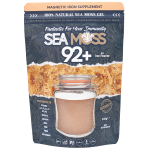
trees now planted
DANDELION

Dandelion is an ingredient within our iron fluorine mix which is present in Magnetic Iron Supplement blend. Below you will find fascinating information and key benefits about this ingredient.
Dandelion is not a simple weed -it is extremely nutritious and can help to fight high blood pressure and some cancers as well as boost the immune system. It is a diuretic and rich in fibre, making it great for treating digestive and intestinal disorders such as constipation.
Also known as taraxacum, the dandelion is part of a family of wildflowers native to Eurasia and North America. The name ‘dandelion’ comes from ‘dent-de-lion’ meaning ‘lion’s tooth’ in French. Of course, this is the name given to the common weed found in many places across Europe.
The dandelion has been used in traditional medicine for centuries and the whole plant contains multiple nutrients including fibre, iron, calcium, potassium and Vitamins A, C, E and K. It is also rich in antioxidants such as beta-carotene and polyphenols, which are used to combat ageing and prevent cell damage and cancers.
Dandelion is a diuretic as well as a source of potassium, both of which are linked to lower blood pressure. Studies have also suggested that dandelion root has the power to dramatically reduce the growth rate of cancer cells in the liver, pancreas and colon. Dandelion root is also a rich source of a fibre called inulin, which is needed for healthy digestion and explains why dandelion is also used to treat conditions such as constipation and indigestion. The whole plant is also full of both antibacterial and antiviral properties, which helps boost the immune system.
Dandelion is safe to use for most people, but you should note that it is a powerful diuretic. If you are already taking diuretic medication, dandelion may cause you to lose too much water. It can also interfere with lithium and similar medications or antibiotics such as Cipro, Levaquin and Noroxin. Avoid taking any of these.
Key benefits of dandelion include:
- Anti-Inflammatory Properties: Dandelion root contains various compounds, including flavonoids and sesquiterpene lactones, which have anti-inflammatory properties. These compounds can help reduce inflammation in the body and have benefits for inflammatory conditions such as arthritis and inflammatory bowel disease.
- Blood Sugar Control: Dandelion root can help regulate blood sugar levels. The extract can enhance insulin sensitivity and reduce blood sugar levels.
- Cardiovascular Health: Dandelion contains antioxidant and diuretic properties and has the ability to regulate blood glucose and cholesterol levels. Dandelion root is a great supplement to promote cardiovascular health and help alleviate metabolic syndrome.
- Cholesterol Control: Dandelion root possesses hypolipidemic properties, which improves blood lipid profiles.
- Digestive Health: Dandelion root has been used as a digestive aid and mild laxative. The extract can stimulate the production of digestive enzymes, improve bile flow, and support healthy gut bacteria.
- Liver Health: Dandelion root has traditionally been used to support liver health. The extract can help promote liver detoxification, increase bile production, and protect liver cells from oxidative stress. These effects can contribute to liver health and function.
Avoid combining dandelion with the following medications:
- Diuretics (Water Pills): Dandelion has diuretic properties and may increase urine production. Concurrent use with other diuretic medications could lead to excessive diuresis and electrolyte imbalance. Monitor fluid and electrolyte levels closely and consult with a healthcare provider.
- Anticoagulant Medications: Dandelion may have mild blood-thinning effects. Combining it with anticoagulant medications such as warfarin or aspirin could increase the risk of bleeding. Monitor for signs of bleeding and consult with a healthcare provider.
- Antidiabetic Medications: Dandelion may affect blood sugar levels. Concurrent use with antidiabetic medications could enhance the effects, leading to hypoglycaemia (low blood sugar levels). Monitor blood sugar levels closely and consult with a healthcare provider.
- Lithium: Dandelion may decrease the elimination of lithium from the body, leading to increased lithium levels and potential toxicity. Avoid concurrent use of dandelion and lithium without medical supervision.
- Potassium-Sparing Diuretics: Dandelion may increase potassium levels in the body. Concurrent use with potassium-sparing diuretics could lead to hyperkalaemia (high potassium levels). Monitor potassium levels closely and consult with a healthcare provider.
- Cytochrome P450 1A2 (CYP1A2) Substrates: Dandelion may affect the activity of CYP1A2 enzymes in the liver, potentially altering the metabolism of drugs that are substrates for these enzymes. This interaction could affect the efficacy or safety of medications metabolized by CYP1A2, such as theophylline, caffeine, or certain psychiatric medications. Consult with a healthcare provider if you are taking CYP1A2 substrates concurrently with dandelion.
- Glucuronide Drugs: Dandelion may influence the activity of glucuronidation enzymes in the liver, which are responsible for metabolizing certain drugs into glucuronide conjugates for excretion. This interaction could potentially affect the metabolism and clearance of drugs that undergo glucuronidation, such as some nonsteroidal anti-inflammatory drugs (NSAIDs) or certain steroids. Use caution when combining dandelion with glucuronide drugs, and consult with a healthcare provider for personalised advice.
- Quinolone Antibiotics: Dandelion may interact with quinolone antibiotics, such as ciprofloxacin or levofloxacin, by interfering with their absorption or efficacy. Concurrent use of dandelion and quinolone antibiotics may reduce the effectiveness of the antibiotics or alter their pharmacokinetics. It's advisable to avoid concurrent use of dandelion and quinolone antibiotics unless under medical supervision.
Individuals with the following allergens or medical conditions should use caution or avoid dandelion:
- Allergies to Asteraceae Plants: Dandelion belongs to the Asteraceae family, which includes ragweed, marigold, and daisies. Individuals with known allergies to Asteraceae plants may also be allergic to dandelion. Symptoms can include skin rash, itching, swelling, or respiratory issues such as difficulty breathing. Use dandelion cautiously if you have known Asteraceae plant allergies.
- Gastrointestinal Disorders: Dandelion may have diuretic and laxative effects, which could exacerbate gastrointestinal issues such as gastroesophageal reflux disease (GERD), irritable bowel syndrome (IBS), or diverticulitis in some individuals. If you have these conditions, monitor your symptoms and consider avoiding dandelion if it worsens your gastrointestinal symptoms.
- Gallstones or Biliary Tract Disorders: Dandelion may stimulate bile production and gallbladder contractions, which could potentially exacerbate symptoms in individuals with gallstones or biliary tract disorders, such as pain or discomfort. If you have these conditions or concerns about gallbladder health, use dandelion cautiously and consult with a healthcare provider.
- Pregnancy and Breastfeeding: Limited safety information is available regarding the use of dandelion during pregnancy and breastfeeding. Pregnant or breastfeeding individuals should consult with a healthcare provider before using dandelion to ensure safety.
- Kidney disease: For individuals with renal insufficiency, dandelion should be used with caution. Dandelion has diuretic properties and may increase urine production, potentially affecting kidney function. It's advisable to consult with a healthcare provider before using dandelion if you have renal insufficiency to determine the appropriate dosage and monitor kidney function.
- Scheduled surgery: Individuals scheduled for surgery should avoid dandelion consumption, particularly close to the surgical date. Dandelion may have effects on blood clotting and bleeding, which could increase the risk of excessive bleeding during or after surgery. It's best to discontinue dandelion use before surgery and follow the guidance of healthcare professionals.
- Bleeding disorders: For individuals with bleeding disorders, dandelion should also be used cautiously due to its potential to interfere with blood clotting mechanisms. Dandelion may exacerbate bleeding tendencies, increasing the risk of haemorrhage or excessive bleeding. It's essential to consult with a healthcare provider before using dandelion if you have a bleeding disorder and to monitor for signs of bleeding.
Recommended Products
DIVE DEEPER
Dandelion root, 100g
Vitamins present |
Value |
Minerals present |
Value |
|---|---|---|---|
|
Vitamin B9/Folate/Folic acid |
27µg - 7% |
Calcium |
190mg - 19% |
|
Vitamin A |
5070µg - 564% |
Iron |
7mg - 38% |
|
Vitamin C |
34.8mg - 58% |
Magnesium |
36mg - 12% |
|
Vitamin E |
3.44µg - 23% |
Phosphorus |
66µg - 9% |
|
Vitamin K |
778.4µg - 645% |


